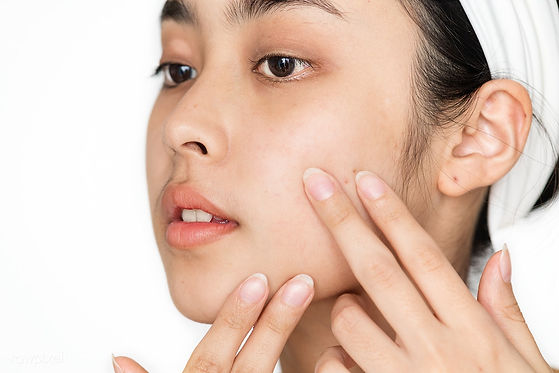
Perfect skin is not a dream anymore
Korea is gaining recognition for its effective beauty products, specially skincare.
scroll
BY: TIFFANY FUNG
You are walking down the street and keep encountering strangers with smooth skin. You begin thinking to yourself, “It would be amazing if I could have such skin too.” Wondering how to achieve that, you walk into Sephora to search for skincare products. Next thing you know, you’re facing a shelf full of sheet masks, which are originated from the country of beauty: Korea.
Korean Beauty, or K-Beauty, is becoming mainstream in Western countries, where it’s mostly known for its focus on skincare. “Having flawless skin is basically the essence of K-Beauty,” says Selina Cheung, a former employee at The Face Shop, a Korean make-up brand that has multiple stores in Toronto. Cheung mentioned at The Face Shop, the best-selling products are all skincare related, such as facial cleansers.


One reason why K-Beauty products are so popular around the world is because they often use natural ingredients. A Korean beauty store in Toronto named Holika Holika sells an aloe cream, which is 99 per cent real aloe. Another brand called Missha sells a line of skincare products, which 82 per cent of the ingredients is bee pollen.
Affordability is another reason for K-Beauty’s popularity. According to Amy Erdman, a Korean-American beauty blogger, Korean products are of high quality but sell at drug store prices.
“They [consumers] can spend 50 dollars and get a whole skincare routine,” Erdman says. “You get a lot more for your money.”
But here are three reasons why K-Beauty has really taken off in the West.
K-beauty has become mainstream.
Karen Yeung, manager at Holika Holika, says she sees many non-Asian visiting her shop, and many of them are repeat customers. “They can see the difference because their coworkers compliment them.” Cheung used to see non-Asian consumers at The Face Shop, too. She said a common question from those buyers is: “What can I use to whiten my skin?” People’s general image of Korean is that they have youthful skin, so they think their skin will become nice too if they start using Korean products.
It must be noted that, while the Korean idea of beautiful skin is pale and shiny and the marketing around K-Beauty products is usually not very inclusive, the skincare routine itself can be used by people of all skin tones and types.
To add on, Alice Zhou, an employee at Missha, mentioned people who know nothing about K-Beauty often shop at her store for skincare products, “I see a lot of customers coming in to buy skincare rather than Western stores.” Zhou said social media help spread K-Beauty, and a Chinese e-commerce application named Xiao Hong Shu is an example.
“I see a lot of customers coming in to buy skincare rather than Western stores.”
-ALICE ZHOU
“The Korean government is heavily supporting the advertising of K-Beauty as an exported good."
-AMY ERDMAN
Purchasing K-Beauty products oversea is easier compared to before.
Erdman said the only way to purchase K-Beauty products before was through unsafe websites. With K-Beauty’s recognition rising, secure websites are appearing, including YesStyle. These safe websites are available in English and charge in foreign currencies like Canadian dollars.
K-beauty stores can be found inside Western malls, too. Yeung explained her store is operating outside of Korea to gain recognition. There are now many business opportunities in Western countries due to the high demand of K-Beauty products, said Alice Zhou, an employee at Missha.
The Korean government plays an important role in the easy access to K-Beauty. “The Korean government is heavily supporting the advertising of K-Beauty as an exported good,” Erdman says, which explains the convenience of buying Korean products even if you’re not in Korea.
Western companies are producing their own version of K-Beauty.
“K-Beauty is being seen as desirable,” Cheung states. Some Western brands recognize the current trends in the beauty industry, so they’re starting to create their own K-Beauty products.
BB Cushions (sponges soaked in BB cream) were invented in Korea. They’re similar to foundation, but have a lighter coverage and an easier application. You press the cushion into the sponge of foundation, then pat the cushion on your skin until you’re satisfied with the result. Now, Dior and Lancôme are selling their own BB Cushions.
Sheet masks were one of the first Korean products that received attention oversea. These are easy to use; you leave one on your face for 15 to 20 minutes, then rinse. As with BB Cushions, masks are being made by Western brands. “Sephora has a whole library of masks that they sell,” Erdman points out. Even drug stores like Shoppers Drug Mart sell masks from Western brands such as Estée Lauder and Skin Republic.
“K-Beauty is being seen as desirable."
-SELINA CHEUNG

There is no doubt K-Beauty will continue to grow globally. Zhou said bee pollen products will possibly be the next trend, as they are already widespread in South Korea.
"The world's perception of Koreans is that they have perfect skin," Cheung says. Luckily, this is no longer limited to Koreans.
Photo courtesy: Huyen Luong Ngoc (pixabay), Ake (rawpixel), Min An (pexels), Kori Nori (unsplash).
The comparison between American and Korean make-up is very big. The main difference is the overall feeling – American’s is more exaggerating whereas Korean’s is more natural.
American make-up style:
Arched eyebrows
Dark eye shadow (ex. brown, gold)
Thick eyeliner that arches up near the end
Longer and fuller eyelashes
Obvious highlight
Nude and dark lip colour
VS.
Korean make-up style:
Straight eyebrows
Light and natural eye shadow (ex. orange, pink)
Thin eyeliner that goes down near the end
Natural curl eyelashes
Obvious blush
Bright lip colour